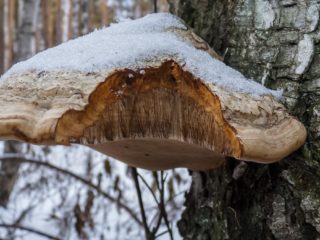Content
The real tinder fungus is an inedible but medicinal representative of the Polyporaceae family. The species is unique, growing everywhere, on damaged trunks of deciduous trees. Since it has medicinal properties, it is widely used in folk medicine. But before starting self-medication, you need to know the external description, view photos and videos, and consult with a specialist.
Where does the true tinder fungus grow?
The real tinder fungus can be found anywhere in Russia. It prefers to settle on damaged, rotten deciduous wood. Also, single specimens grow on stumps, dead wood and fallen trees.
When settling on a living tree, the fungus develops white rot on it, as a result of which the wood turns into dust and disintegrates into plates. Spores begin to develop rapidly after penetrating into the trunk through cracks, mechanical damage to the bark and branches.
What does a blood sponge mushroom look like?
Getting to know this representative of the forest kingdom must begin with external characteristics.
At a young age, the species has a semicircular shape; as it grows, it becomes hoof-shaped. Since the mushroom does not have a stem, it grows to the tree with its side. An adult fruiting body reaches 40 cm in diameter and 20 cm in thickness. The wavy, slightly ribbed surface is smooth, and when fully ripe it becomes covered with small cracks. The dense top matte layer with clearly visible concentric zones is colored light gray, beige or ocher.
The pulp is hard, cork-like, velvety to the touch when cut. Color yellow or brown. A mushroom without taste, but with a pleasant fruity aroma. The bottom layer is painted gray-whitish; when pressed, a dark spot appears. Reproduction occurs by microscopic, cylindrical, colorless spores.

The fungus grows on both living and dead wood
Is it possible to eat real tinder fungus?
The real tinder fungus is not used in cooking due to its hard pulp. But due to its beneficial properties, mushroom pickers collect it to prepare healing infusions and decoctions.
Medicinal properties and uses of the tinder fungus
The polypore true fomesfomentarius, or as it is popularly called “blood sponge,” is widely used in folk medicine. Medicinal properties:
- stops the growth of cancer cells;
- stops bleeding, the pulp perfectly absorbs blood, and the mushroom can be used instead of a bandage;
- thanks to agaric acid, it removes toxins and bad cholesterol;
- cleanses the liver of toxins and restores cells;
- helps with respiratory diseases.
This representative of the forest kingdom has been known since ancient times. In Ancient Greece, the mushroom was used to treat gastrointestinal diseases, and with its help they got rid of stress and depression. It was also used in surgery as a hemostatic material.
In China, the mushroom is recommended for people with obesity, digestive problems, and impotence. And women use mushroom-based products to improve the condition of their skin, nails and hair.
False doubles
This forest dweller, like any representative of the mushroom kingdom, has similar doubles. Such as:
- False – an inedible specimen grows on living deciduous wood. When infected, white rot appears on the tree, which leads to its death. The species can be recognized by its kidney-shaped or spherical shape with a brown-ocher color. The pulp is thick, hard, reddish-brown in color. The pulp has no smell or taste.
The species infects wood with white rot
- Bordered - a perennial and inedible species, shaped like a small hoof. The surface with pronounced concentric zones is painted bluish-gray. The beige or light brown pulp is dense, woody, tasteless and odorless. The species is a saprophyte; when wood is destroyed, the soil is enriched with nutrients and becomes fertile.Fruiting bodies are used in Chinese medicine to treat blood disorders.
This species can cure blood diseases
Collection rules
The collection of tinder fungus is carried out all year round. To do this, the mushroom growing on living wood is carefully cut off with a sharp knife. The harvested crop can be dried and infusions can be made from it. The prepared medicine is stored in the refrigerator for no more than six months.
Infusions are made from freshly picked mushrooms poured with boiling water or vodka. Infuse and take for a month, 2 times a year.
Since the real tinder fungus has similar counterparts, before mushroom hunting you need to carefully read the description and look at the photo.
Conclusion
The real tinder fungus is a medicinal representative of the mushroom kingdom. It grows on dead and living wood and bears fruit all year round. Due to its hard, dense pulp, the mushroom is not used in cooking.










